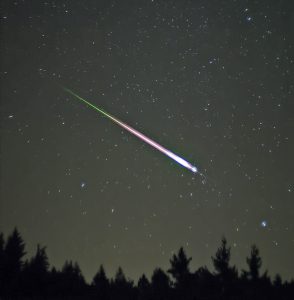11 December 2017
Please visit the 2017 Fall Meeting Media Center to view previous media advisories and press releases that include important information about press registration, badge pickup, press conferences, potentially newsworthy presentations, quiet rooms, online media resources, searching the scientific program and AGU On-Demand.

A meteor during the peak of the 2009 Leonid Meteor Shower. New research shows air particles penetrate the meteors’ porous interiors as they careen through the atmosphere. These air particles create pockets of high pressure that ultimately lead the rock to explode from the inside, tens of kilometers above the Earth.
Credit: Navicore (Own work), CC BY 3.0 via Wikimedia Commons.
NEW ORLEANS — Researchers have identified an explosive new mechanism that breaks down meteors as they hurtle toward Earth.
New simulations of falling meteors suggest air particles penetrate the space rocks’ porous interiors as they careen through the atmosphere. These air particles create pockets of high pressure that ultimately lead the rock to explode from the inside, tens of kilometers above the Earth.
By uncovering this new way in which Earth’s atmosphere breaks up meteors, the new finding suggests the atmosphere may provide better protection against meteors than previously believed, according to Jay Melosh, a geophysicist at Purdue University in West Lafayette, Indiana.
“There’s more going on than what had been thought before,” said Melosh, who will present the new research today at the 2017 American Geophysical Union Fall Meeting in New Orleans. “Bottom line is that the atmosphere is a better screen against small impacts than we had thought.”
Meteors are small asteroids and other extraterrestrial rocks that have entered Earth’s atmosphere from space, reaching speeds up to 40 times faster than a bullet as they race toward the ground. NASA estimates 44,000 kilograms (48.5 tons) of meteoritic matter lands on Earth every day, roughly the same weight as seven African elephants.
The friction generated between a falling meteor and the surrounding air particles can heat up the rock to the point of disintegration, but the new research suggests the air particles can also break up the meteor from the inside.
The new research considers an often-overlooked feature of meteors: their porosity. Meteors are like piles of rubble, riddled with fractures and pores, but researchers had not previously considered how the percolation of air through the meteor could affect their breakup, according to Melosh.

This graphic depicts a comparison of the breakup of a 20-meter (66-foot) diameter meteoroid (similar to the Chelyabinsk asteroid) during the final moments of its flight after entering the atmosphere at an angle of 45° from the horizontal and a speed of 15 kilometers per second (9 miles per second). The time after entry and altitude are shown above each figure and the color depicts the percentage of solid material in each computational cell. The left panel shows an asteroid that is 10 percent porous and the right panel a 30 percent porous asteroid. The more porous asteroid almost entirely disintegrates, while the less porous one breaks up but is not dispersed.
Credit: Jay Melosh.
Melosh and his colleagues uncovered the air percolation mechanism while simulating the 2013 Chelyabinsk event, where a 20-meter (60-foot) wide meteor exploded 29.7 kilometers (18.5 miles) above the Russian Ural Mountains. Their objective was to better understand how the meteor had disintegrated and evaporated in the atmosphere. Previous simulations for modeling meteor entry relied on computer codes commonly used to analyze how spacecraft return to the atmosphere, but these codes don’t account for the porosity of the meteor.
Instead, the researchers used computer codes first developed by Los Alamos National Laboratory to model nuclear reactor explosions. For the new research, the models were used to account for meteoroids’ loose conglomerate composition.
The simulations showed that the atmosphere buffets against the meteor’s side facing Earth, forming a dense pocket of air in front of the rock. On the flip side, the meteor’s wake creates a vacuum. The pressurized air bubble ahead of the meteor is strongly attracted to the low-pressure environment developing behind the meteor, causing air particles to rapidly flow through the rock’s cracks and holes from the front to the back of the rock. The high-pressure air moving through the meteor forces the fragments apart, causing the meteor to disintegrate in the upper atmosphere.
The new findings were published today in Meteoritics & Planetary Science.
###
The American Geophysical Union is dedicated to advancing the Earth and space sciences for the benefit of humanity through its scholarly publications, conferences, and outreach programs. AGU is a not-for-profit, professional, scientific organization representing more than 60,000 members in 139 countries. Join the conversation on Facebook, Twitter, YouTube, and our other social media channels.
Notes for Journalists
Lead researcher Jay Melosh will give a poster presentation about this research on Monday, 11 December at the 2017 AGU Fall Meeting.
Poster title:
Enhanced Breakup of Entering Meteoroids by Internal Air Percolation
Session:
NH13A: Asteroids: Surveys, Characterization, Impact Risk, and Mitigation II Posters
Date: Monday, 11 December 2017
Time: 1:40 – 6:00 p.m. CST
Location: Morial Convention Center, Poster Hall, Halls D-F
Abstract number: NH13A-0108
Contact information for the researcher:
Jay Melosh, Purdue University, West Lafayette, Indiana, U.S.A.: [email protected], +1 (520) 243-9761.
Related paper:
Air Penetration Enhances Fragmentation of Entering Meteoroids
Nanci Bompey
+1 (914) 552-5759
[email protected]
Lauren Lipuma
+1 (504) 427-6069
[email protected]
AGU Fall Meeting Press Room:
Morial Convention Center, Room 350-351
+1 (504) 670-5513
[email protected]